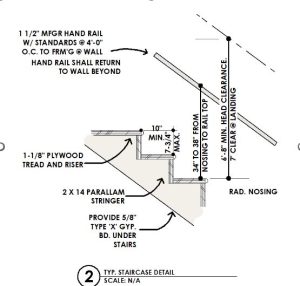We just sent out a demand on a case involving a North Georgia winery where the risers, the up part of a stair, were all of varying heights and when our client walked down them for the first time, she lost her footing and fell, hitting her head on a table nearby.
The adjuster for the insurance company at first did not follow the legal argument, so I asked them to measure the risers and, sure enough, they were all in violation of Georgia Building Code. Stairs are supposed to all be of very close measurements so that the pedestrian can climb or descend in a rhythm.
The diagram below illustrates the requirements for stairs that establish the standard of care for static defect fall cases.
The following analysis of an older appellate opinion gives a useful illustration of how the Code can establish a case and allow the injured party to establish that the fall was not their fault and was the result of faulty step construction.
The appellate opinion in Murray v. West Building Materials of Georgia provides a detailed analysis of a premises liability personal injury case involving a fall accident on the defendant’s property.
Barbara Murray filed a lawsuit against West Building Materials of Georgia after sustaining injuries from falling while descending the steps at their store. The key issue in the case was whether West had actual or constructive knowledge of the hazardous condition of the steps, and whether Murray lacked knowledge of the hazard despite exercising ordinary care.
The record showed that Murray fell while descending the concrete steps at West’s store, and an expert witness testified that the steps and handrail did not meet building code requirements, potentially causing Murray’s fall.
Despite this, the trial court granted summary judgment to West, concluding that there was no genuine issue of material fact regarding Murray’s claim. The Court of Appeals of Georgia conducted a de novo review of the case, considering all evidence and inferences in favor of the nonmoving party, Murray.
In analyzing the case, the Court referred to the Supreme Court of Georgia’s decision in Robinson v. Kroger Co., which outlined the requirements for a slip-and-fall plaintiff to recover damages. The plaintiff must prove that the defendant had knowledge of the hazard and that the plaintiff lacked knowledge of the hazard despite exercising ordinary care. The Court noted that Murray presented evidence that the steps were constructed in 1995 and had been in use since then, supporting the inference that West had knowledge of the hazardous condition.
Regarding Murray’s lack of knowledge of the hazard, the Court applied the rule from Robinson that the plaintiff’s evidentiary burden on this issue does not arise until the defendant establishes negligence on the part of the plaintiff. West argued that Murray’s previous successful use of the steps indicated her knowledge of the alleged dangerous condition, but the Court rejected this argument. The Court found that the irregularities in the steps, combined with the too-short handrail, created a unique hazard that Murray may not have appreciated despite prior use of the steps. The key fact was that Murray had only gone up the steps and had not previously descended them. Steps look different and are climbed differently, depending on which way one is headed.
In conclusion, the Court reversed the trial court’s grant of summary judgment to West and gave Murray the opportunity to try her case to a jury.
If you have been injured in a slip-and-fall accident on someone else’s property, it is essential to consult with a qualified personal injury attorney to assess your legal options and seek appropriate compensation. The appellate opinion in Murray v. West Building Materials of Georgia demonstrates the complexities of premises liability cases and the importance of presenting strong evidence to support your claim.
 Atlanta Injury Attorney Blog
Atlanta Injury Attorney Blog


